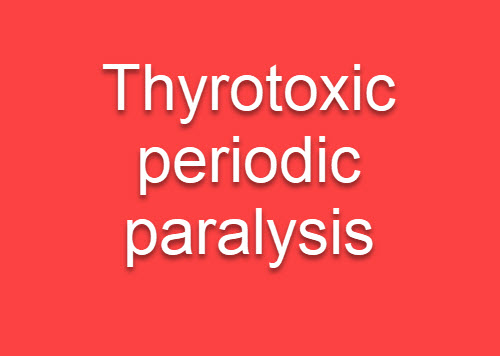Last Updated on October 28, 2023
Thyrotoxic periodic paralysis is a type of secondary periodic paralysis that leads to recurrent muscle weakness and is associated with hyperthyroidism and hypokalemia is usually present during attacks.
It is most commonly seen in Asian men, is characterized by abrupt onset of hypokalemia and paralysis.
The presentation is similar to familial hypokalemic periodic paralysis and often cause for confusion.
It is important to distinguish thyrotoxic periodic paralysis from familial hypokalemic periodic paralysis. Following are the differentiating features
- Absence of a family history of paralysis
- Male sex
- Presentation in the second to fourth decades of life
- Signs of thyrotoxicosis
Thyrotoxic periodic paralysis is most common in Asian populations, with an incidence of approximately 2% in patients with thyrotoxicosis of any cause.

The typical age of onset is 20–40 years.
It is not unknown why males are predominantly affected despite hyperthyroidism being much more common in women.
the paralysis is not related to the etiology, severity, and duration of thyrotoxicosis and is most commonly seen in Grave’s disease.
Family history of periodic paralysis is usually absent
Genetic mutations in the L-type calcium channel α1-subunit (Cav1.1) have been described in some population
Thyroid disease associated with Thyrotoxic Periodic Paralysis
- Graves’ disease
- Thyroiditis
- Toxic nodular goiter
- Toxic adenoma
- TSH-producing pituitary adenoma
- Excessive ingestion of thyroxine or iodine
- Amiodarone-induced hyperthyroidism.
Pathophysiology
The muscle weakness result from markedly reduced levels of potassium in the bloodstream. There is no actual loss of potassium in the body.
There is increased Na+/K+-ATPase activity that leads to shift of potassium into tissues, and depletes potassium from the circulation. Hypokalemia leads to hyperpolarization of muscle cells, making the neuromuscular junction less responsive to normal nerve impulses.
It is not clear but suspected that the enzyme becomes more active due to increased thyroid hormone levels.
Hyperthyroidism may result in a hyperadrenergic state, which may lead to the activation of the Na+/K+–ATPase pump and result in cellular uptake of potassium.
Thyroid hormones may also directly stimulate Na+/K+– ATPase activity and increase the number and sensitivity of beta receptors. Hyperinsulinemia has been found during the during episodes of paralysis. That may explain the attacks after high-carbohydrate meals but exact mechanism is not known.
Various trigger factors that can precipitate the paralysis are
- Trauma
- Exposure to cold
- Emotional stress
- Infection
- Alcohol ingestion
- Menses
- Drug
- Diuretics
- Insulin
- Steroids
Clinical manifestations
There is acute onset of weakness of proximal musculature of lower-extremity which mat be ascending in nature.Rarely does the paralysis affect ocular, bulbar, or respiratory muscles. There have been some reports of ventialtion being affected.
The weakness usually occurs int during the early morning hours or while resting after strenuous exertion and a high-carbohydrate meal.
Acute episodes may be preceded by muscle aches, cramps, and muscle stiffness.
A history should be sought for triggers.
On examination, the deep tendon reflexes are decreased or absent.
Sensation and level of consciousness are usually spared.
There might be subtle finding suggesting thyrotoxicosis
- Warm and moist skin
- Fever
- Tachycardia
- Exophthalmoses
- Goiter
The paralysis can last 3 to 96 hours, and it resolves in the reverse order from which it occurred.
Lab Studies
Following findings could be present
- Hypokalemia
- Hypophosphatemia
- mild hypomagnesemia
- Normal acid-base balance
- Low potassium excretion rate
- (low urinary potassium—creatinine ratio <2 and low TTKG <3)
- If high shows urinary potassium loss
- Hypercalciuria – incresed loss of calcium in urine
- hypophosphaturia – Decrease in urine phosphate
- Abnormal thyroid function tests
- Low TSH
- Elevated free and total T3 and T4
ECG abnormalities
- Sinus tachycardia [Unlike hypokalemia from other causes]
- Hypokalemic changes
- Prominent U wave
- Prolonged PR interval
- Increased P-wave amplitude
- Widened QRS complexes
- First-degree atrioventricular block
- Atrial and ventricular arrhythmias
Differential Diagnosis
Here is a list of differential diagnoses of paralyses associated with hypokalemia [other than thyrotoxiv periodic paralysis]
Type of potassium imbalance due to Transcellular shift
- Familial periodic paralysis
- Barium poisoning
- Drugs
- Diuretics
- Tocolytics
- Theophylline toxicity
- Chloroquine toxicity
- Insulin overdose
- Primary hyperaldosteronism
- Pseudohyperaldosteronism: licorice ingestion
Renal loss of potassium
- Bartter’s syndrome
- Gitelman’s syndrome
- Renal tubular acidosis
- Nephrotic syndrome
- Aacute tubular necrosis
- Diabetic ketoacidosis
- Ureterosigmoidostomy
- Celiac disease
- Tropical sprue
Gastrointestinal loss of potassium
- Infectious diarrhea
- Salmonella enteritis
- Strongyloides enteritis
- Yersinia enterocolitis
- Short bowel syndrome
Thyroid function tests on the blood are used to differentiate thyroid periodic paralysis. These are normal in the other forms.
Treatment of Thyrotoxic Periodic Paralysis
Acute Therapy
Correction of Hypokalemia
- Intravenous or oral potassium
- Hasten muscle recovery
- Prevent cardiopulmonary complications
- Risk of rebound hyperkalemia
- Release of potassium and phosphate from the cells on recovery
- Occurrs in approximately 40% of patients
- Greater risk if they received >90 mEq of potassium chloride within the first 24 hours (
- Those who receive a total dose of ≤50 mEq of potassium chloride rarely develop rebound hyperkalemia.
- Release of potassium and phosphate from the cells on recovery
Propanolol
- A nonselective beta-blocker
- Prevents the intracellular shift of potassium and phosphate by blunting the hyperadrenergic stimulation of Na+/ K+–ATPase
- Given alone either orally (3 mg/kg) or intravenously
- Normalizes serum potassium levels on an average of 120 minutes
- Can be given as initial therapy
The combination of nonselective beta-blockers and low-dose potassium appears to be the treatment of choice for facilitating recovery and reducing rebound hyperkalemia.
Definitive Therapy
- Treatment of hyperthyroidism
- Antithyroid medications
- Surgical thyroidectomy
- Radioiodine therapy.
Thyrotoxic periodic paralysis curable once a euthyroid [normal levels] state is achieved and leads to resolution of the paralytic attacks.
